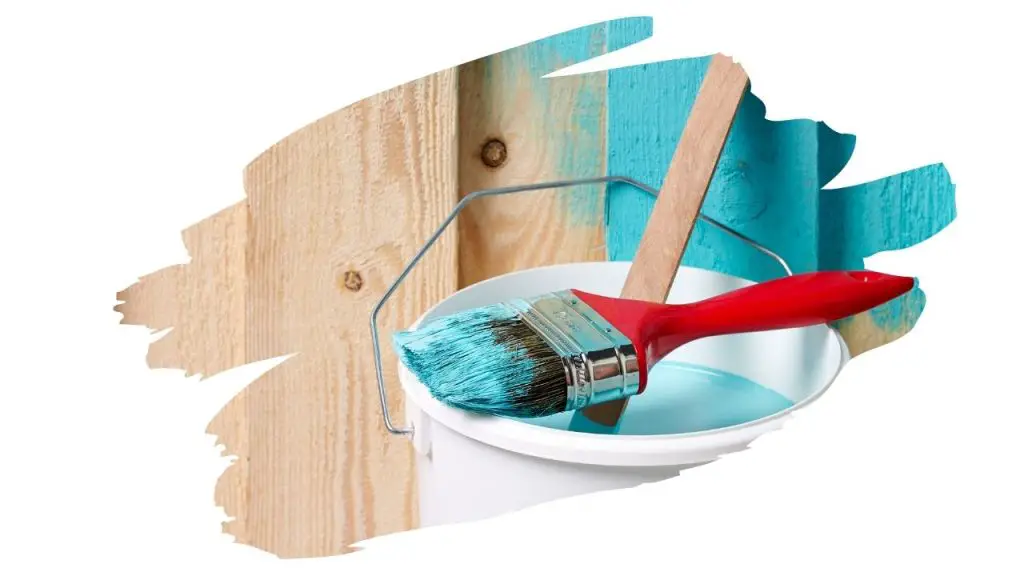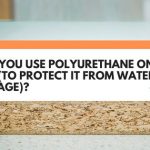Okay, so here’s the deal. Let’s say you want to finish off and protect a wooden surface so that it looks glossy and super smooth. A few coats of polyurethane should be able to get that job done.
But now lets add in a bit of a complication in the form of a coat of paint. Let’s say you also want to give that smooth timber surface a coat of acrylic color that’ll really make it stand out.
How do you both apply that protective polyurethane AND get a smooth brush-stroke-free coverage of paint onto the woodwork?
In other words, can you really get the best of both worlds and simply mix paint and polyurethane together?
While you could mix acrylic paint with a water-based polyurethane, it isn’t best practice. Ideally, you should apply the coat of paint first. And then after that coat of paint cures, you would then apply protective coats of polyurethane. What’s more, certain types of paint such as latex paint, do not mix well with alkyd-based polyurethane finishes.
So, having said that, is mixing paint with polyurethane really such a bad idea? Plus, surely you could save time by blending them so that you are able to get two finishing jobs done with one stroke of a brush.
Well, here’s the catch… the type of paint you are mixing into that polyurethane really does matter. Get it wrong, and your whole piece could be ruined by a bad paint job.
So keep reading to find out why two separate coats of polyurethane and paint is often much better than one…

This post may contain affiliate links to products that we receive a commission for (at no additional cost to you). Learn more here.
So, What Happens When You Mix Paint With Polyurethane?
Well, as a general rule of thumb, mixing these two products does little more than ruin both the paint and the polyurethane solutions.
The Problem With Blending Acrylic Paint With Polyurethane
The core of the issue here lies in the age old problem of mixing water with oil.
Oil and water don’t mix. In fact, oil molecules like to shove away water molecules. And this results in oil clumping together as it floats around in that H2O.
Now, if you were to try and mix say a water-based acrylic into oil-based polyurethane, a similar reaction will happen to that blend. You will end up with a clumpy congealed-looking mess of an end product that is no good for anything.
Acrylic paint might not always play well with polyurethane, but it’s not the only finish with this issue. Other sealants, such as epoxy resin, can cause a few problems too. You can learn all about it in our post ‘Can You Apply Epoxy Over Polyurethane? (Your Questions Answered!)‘.
Okay, But Can You Mix Acrylic Paint With Water-Based Polyurethane?
If you want to coat on polyurethane and acrylic paint, then these two solutions should be applied separately. Basically, you need to brush water-based polyurethane over acrylic paint (after the paint has first fully cured).
However, if that acrylic paint is water-based, then you can go ahead and mix it with a water-based polyurethane product. I still wouldn’t really recommend it, but sure, you can have at it.
Also, it is worth noting here that if you are using a flat paint, then mixing it with polyurethane won’t add sheen to the paint. If you want a glossy paint finish, then you should use a soft sheen paint product right off the bat.
Related Post: Will Polyurethane Prevent Water Rings? (Best Practice Revealed)
The Problem With Blending Latex Paint With Polyurethane
When it comes to Latex Paint, the problem here lies in the unusual way that latex paint cures.
What Does Paint ‘Curing’ Actually Mean?
There is a key difference between paint drying and paint curing. And that difference is chemistry.
When paint dries we are describing EVAPORATION. The solvents inside that paint are evaporating into the air.
So that freshly painted scent you smell? That would be those solvents wafting all around you.
And once paint completes that evaporation process, it changes from a wet liquid to a solid film. The evaporation process usually takes just a few hours (up to 24 hours if it is an oil-based paint).
Related Post: 3 Simple Reasons Why Your Gloss Paint Is Not Drying
Now, when paint cures we are describing a CHEMICAL REACTION. This reaction is a process that hardens the paint, turning it from a solid film into a durable and scratch resistant coat.
The process of curing is separate from the process of evaporation (even though they coincide). And curing can take anywhere from 14 days up to 60 days to fully complete.
The Difference In The Way Latex Paint Cures
Most paints, stains, and finishes cure via chemical reaction. However, latex paint likes to change things up a little.
Latex paint is a water-based application that cures via evaporation. This means that latex doesn’t undergo a completely separate hardening chemical reaction process.
Instead, as the water in latex paint evaporates, the latex micro-particles (called ‘polymers’) left behind begin to fuse together and harden all at once.
Long story short, latex paint cures in a very different way to polyurethane, which is a problem if you try to blend the two together. How? Well, if you coat wood with a latex/polyurethane blend you will create curing/drying problems later on.
So, To Sum Up…
Polyurethane is a brilliant way to protect that paint job for years. It is durable, tough, and when you apply a clear coat, it doesn’t even dull the color of the paint either.
But, if you want to properly protect that paint, then you need to apply the polyurethane finish separately. At the end of the day, there is rarely any need to blend paint and polyurethane together at all.



